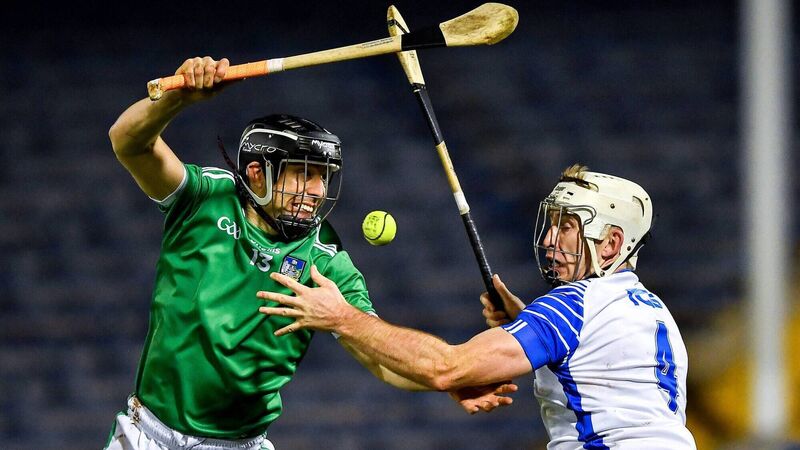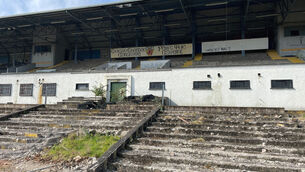Enda McEvoy: Limerick’s pragmatism and remorseless functionality to carry the day

Limerick's Graeme Mulcahy of Limerick battles for possession with Waterford's Shane McNulty in the Munster SHC final. Picture: Ray McManus/Sportsfile
Back around May, during the first lockdown, a random thought occurred. Bad enough, clearly, to be living through a pandemic with no hope or hurling on the horizon. But just imagine being a Limerick player or supporter living through said pandemic.
They were the best team in the country in 2018 and they won the All-Ireland. They were the best team in the country in 2019 and they didn’t win it. They were the best team in the country in 2020 and they weren’t going to be allowed to win it. Just when it looked as though the Unlimited Heartbreak days had become an increasingly distant memory… Normality resumed serendipitously for them.
The very worst-case scenario for Limerick tomorrow is the absence of what ifs. Either they win, thereby sealing their status as Shannonside’s finest offering since the Mackey era, or they weren’t good enough.
Aura
In creating a winning team, John Kiely has also created an aura. Waterford will be required to shatter the aura before they can beat the team.
The Munster champions perspire a relentlessness that all the best teams perspire, each in their own easily identifiable way. If Limerick’s palette isn’t broad — they paint in bold primary colours, not delicate blues and pinks — what of it?
Their goalie is dependable and, as with the finest goalies, boasts a forward’s eye. They defend with the kind of blanket forcefulness that overrides individual weaknesses. Their half-forward line doubles as a half-back line and trebles as a midfield. They knock over points at a rate unseen in the annals of the sport.
The number of personnel and positional differences from the 2018 All-Ireland final looks about right. Not drastic, not insignificant. No stasis, certainly. Of late the evolutionary process has entailed recasting Kyle Hayes as an attacking articulated truck of a wing-back and Cian Lynch as an improbable centre-forward, a sprite between two monsters.
Sui generis in the ancient vernacular, press-resistant in the current vernacular, Lynch is the necessary depth charge in the pint of plain.
The lack of an assassin’s instinct is their one obvious weakness. Limerick do not slit the throats of their enemies and drink their blood; they suffocate them instead. In 18 championship outings over the past three seasons, they’ve outgoaled their opponents in normal time on only seven occasions. They do not make rain inside the last 30 metres of the field.
Reincarnate them as a rugby player and they’d be a number eight. (Tipp would be an out-half.) Their average of 11 wides per outing in Championship 2020 constitutes a matter for mention rather than for angst.
Their 16 wides a fortnight ago may or may not have been a one-off — no team should get within an ass’s roar of perfection in a semi-final — but they’ll hack out more than enough possession here to be able to afford 11 or 12 wides. They may not be able to afford 15 or 16.
Which brings us to the first of caveats. Against Clare, Waterford, and Galway the men in green should have been out the gap long before the end. One cannot keep juggling fire indefinitely in that manner: the old Coventry City syndrome. In the end one will get scorched/relegated.
The similarities in reverse with the 2018 final are worth listing. Limerick may not be the holders but they’re the hot favourites, they’re packed with the type of splendiferous physical specimens Charles Atlas would rave about, they’ve looked likely champions from way back and, so sustained are the volleys of arrows they loose from distance, the lack of goals has been a non-issue.
The difference with two years ago is that Galway were leaking fuel for weeks before the big day whereas no sign of metal fatigue is visible with Limerick.
Conclusion?
Kiely and Paul Kinnerk have consciously been hoarding matches and powder with December 13 in mind. Tomorrow is detonation day. It’ll be no surprise if they light the fuse at the throw-in, attempt to do to Waterford what Kilkenny did to them in 2007 and be gone beyond recall after 10 minutes.
Loughnane called it
The presence of the underdogs won’t have come as a surprise to Ger Loughnane, who on championship eve decreed that the prevailing circumstances left room for an unlikely candidate to get a handy draw and come charging out of left field. Indeed.
The brio of Waterford’s semi-final triumph sent a flare into the skies over a competition that, the novelty of its setting apart, provided little in the way of high drama. Galway found that 2017 was past tense. Wexford found that the train left the station in 2019. Tipperary found yet again that there are no second acts in their lives when they hold the MacCarthy Cup.
Cork and Kilkenny found their level.
The vibrancy with which the Déise hurled a fortnight ago was no accident. Back in January, when nobody was listening, Stephen Bennett revealed that Liam Cahill didn’t mind them making mistakes provided they were “good mistakes”.
Yet after the way in which fortune abandoned them in 2018, as seemingly humble a feat as winning three of their league fixtures back in springtime helped put their world to rights again and replenished stores emptied of confidence.
When the sides met in the Munster final it wasn’t quite a hands and heels job for the winners, but once the jockey produced the whip at the furlong marker and waved it, the race was over.
Cahill was quick to acknowledge his charges’ fatigue in the closing stages and his own failure to drain the bench earlier.
If Waterford also felt they could have reacted quicker once Limerick changed their shape for the closing quarter, it was scarcely a cardinal sin. Kiely’s boys pose more questions of the opposition than anyone since the high Raj days of Cody’s Kilkenny.
The attacking element of the underdogs’ strategy looks straightforward. Win as much high ball and as many of the rucks as they can, then have Calum Lyons and Jamie Barron drive forward. Galway had heavy armour trying to do so; Waterford have guys on motorbikes. For all that hurling become a crucible of long-range markmanship, it still has room for people who can blow holes in walls and make incisions.
But — and here’s a sentence Shannonside folk could not have dreamed a few years ago would be written on the eve of an All-Ireland final — Limerick are not Kilkenny. Limerick think a good game; Kilkenny do not. Kilkenny leaked 2-16 from play in the second half a fortnight ago; Limerick will not concede that across both halves. Besides, setting Lyons back on his heels will be high on their order of business.
Taken off in their first three outings and irritating for the first half of the semi-final, what will Austin Gleeson do tomorrow? Man of the match or the first man subbed? Alternatively he could score three points, which would be more than acceptable.
Some other observations.
On a line through Kilkenny and Galway, the formbook points to Waterford, not Limerick.
Let’s peg 0-25 as the absolute minimum return for the favourites and 1-27 as a perfectly reasonable expectation. Before they can even think of winning, then, the underdogs will need at least two green flags and will need to break the 20-point barrier and then some. They managed 2-17 against Galway in 2017. It wasn’t enough then and it won’t be enough here.
That 2017 iteration included Brick Walsh, Noel Connors, Barry Coughlan, two Mahonys and one Ten (two Fives). All were management-level employees with a blue-collar ethos. That’s a lot of corporate know-how to have departed the building.
The other Limerick caveat?
A vulnerability about the full-back line, particularly in the air, albeit one unplumbed since the Clare game. Then again, Stephen O’Keeffe was poor for Kilkenny’s first goal and Conor Prunty was poor for their second Cahill has surely pondered parking Tadhg De Burca, one of the most important and influential players of his generation, in front of the full-back line for the opening quarter to guard against early exsanguination, with instructions to move upfield thereafter.
Never underestimate the ego of a previewer.
The temptation to plump for a realistic underdog like Waterford is ever a strong one, not least because one can preen oneself indefinitely in the event of victory.
The implicit roseate scenario is not hard to picture. Cahill’s men hang in there for three-quarters of the game and are properly steeled for the last push after the second water break; Gleeson magics up a blinder; a lucky break goes their way 10 minutes from the end; 61 years of hurt are swept aside in late deluge of points.
It’s easier to go with what we know, however, and cite Damon Runyon’s gag about the race not always being to the swift (“but that’s the way to bet”).
Limerick’s pragmatism, practicality, and remorseless functionality to carry the day. Not romantic, alas, but neither are they.
It’s part of what makes Kiely’s Limerick Kiely’s Limerick.







